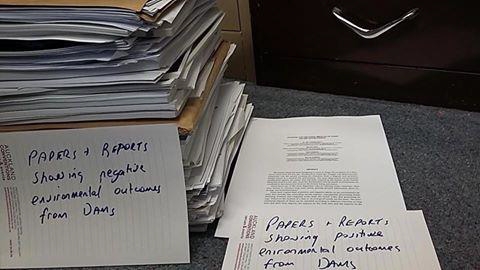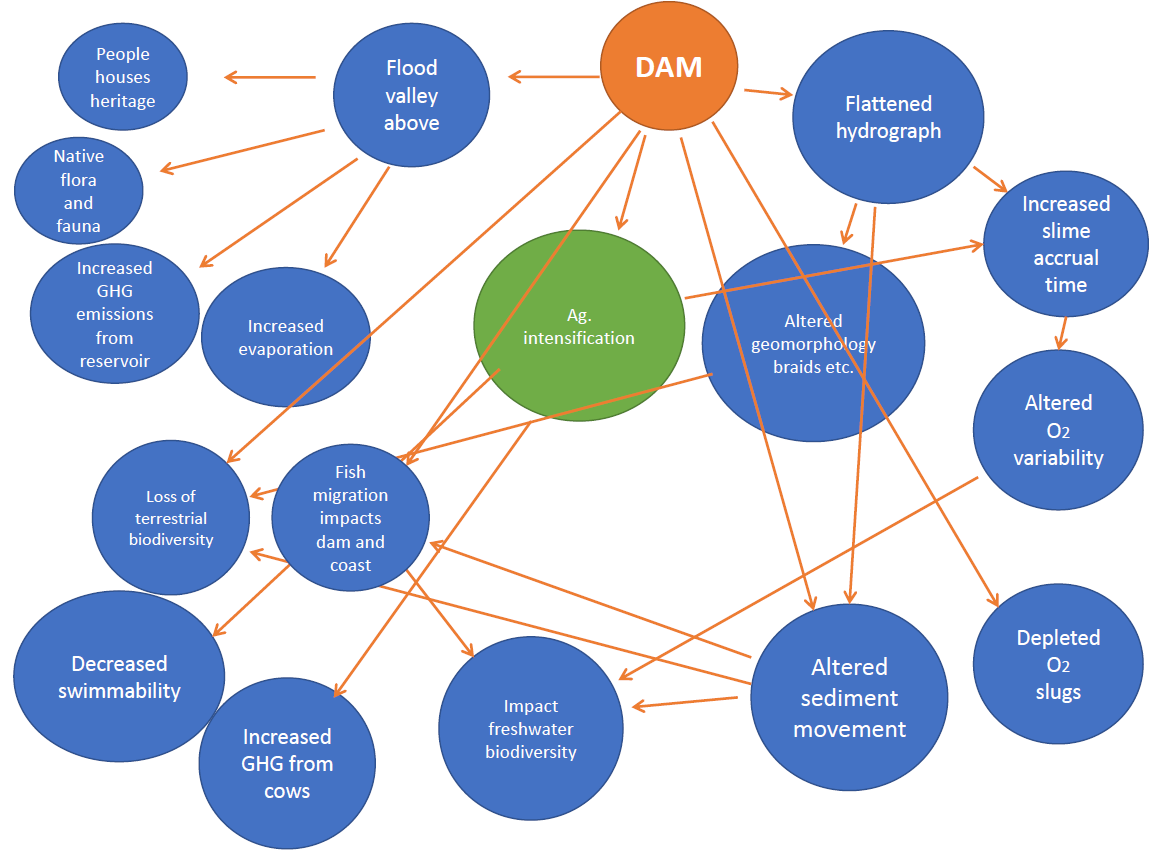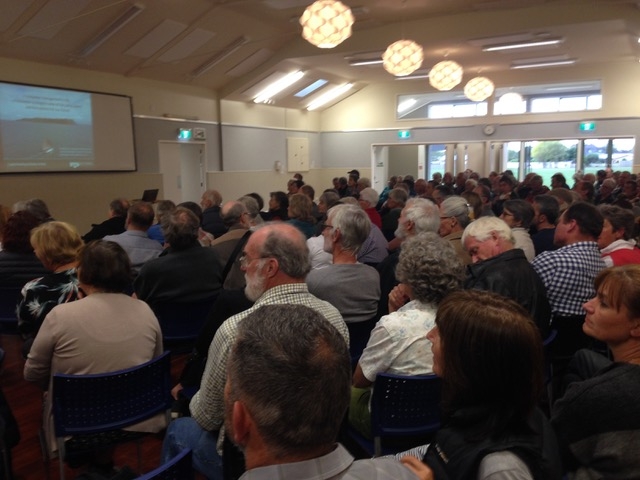One side of the Waimea Dam argument claim that it is an environmental benefit for our region (hence the district-wide rate increase). The other side of the argument is not so convinced, in fact, Dr Joy speaking to a packed crowd at Mapua said the claim is “utter rubbish.”
In their report titled
The problem with nitrogen, they say, is;
Consumption of water contaminated with nitrogen can lead to certain types of cancer and has been linked with blood disease in infants, known as the blue baby syndrome. (It is thought that the ingestion of too much nitrate leads to a decreased ability of the blood to carry oxygen; infants are more susceptible than adults.
In his article, Our deadly nitrogen addiction published in The New Zealand Land & Food Annual Dr Joy digs deeper into the nitrogen issues.
Synthetic nitrogen has allowed the human population to reach double the 3.5 billion that could have been sustained without it. Since the discovery, population growth and the increase in nitrogen fertiliser production have been in sync.
Now we are on track to reach a world population of more than nine billion by 2050, nearly three times what could have been supported without synthetic nitrogen.
As with a wonder drug that only later you discover has terrible side effects, the Haber-Bosch process opened up a Pandora’s Box of problems. By exploiting in a single century energy built up over millennia, we have radically altered the ecological balance of agricultural systems.
You might say that this sounds alarmist and ask if there is any real issue here. Fortunately, Dr Joy had you in mind as he continues:
The distortion triggered a proliferation of livestock so that the food system is now responsible for more than a quarter of all anthropogenic greenhouse gas (GHG) emissions, is the dominant driver of deforestation and biodiversity loss, and is a major user and polluter of water resources.
Nitrogen is not the only fossil-derived part of the problem: oil is another culprit. On top of the nitrogen footprint, our industrial food production system now uses over 10 calories of oil energy to plough, plant, fertilise, harvest, transport, refine, package, store/refrigerate and deliver one calorie of food to be eaten by humans.
On the face of it, we seem to be going backwards with all our fast-forward methods. Future generations will look back our time of greed and see that we have consumed significant amounts of resources in a totally unsustainable fashion. It is not only resources that are being depleted at a great rate of knots.
A graphic example of the human food domination of the planet is that in the last 100 years the biomass of domestic animals on the planet quadrupled. By the beginning of this Century 98 per cent of the total biomass of mammals
It is not only a global cost, but the cost is also very real in New Zealand too according to Dr Joy’s research.
In New Zealand the ratio of nitrogen costs to gains is likely to be similar — put simply, they constitute a net loss for society. One facet of the environmental costs of nitrogen pollution of freshwaters can be quantified by what it costs to remove it from waterways such as lakes.
Trials in Lake Rotorua showed it cost a minimum of $250 to remove one kilogram of nitrogen from the lake, whereas to not use a kilogram of nitrogen fertiliser on
The Bay of Plenty Regional Council is currently paying farmers to de-intensify their farming in the lake catchment order to stop 100 tonnes of reactive nitrogen entering the lake (the estimated amount that must be reduced to stop the lake clarity declining). The regional council has a $40 million tax and ratepayer clean-up fund for the lake.

This conversation is very pertinent to the people of the Waimea Plains. We are being sold a dam that has great community benefit because it is an environmental magic bullet. The underground water on the plains is already under threat from Nitrogen “leakage.” With no current plan on Nitrogen management in the region there is a very real threat that short-term gains by a few irrigators could have significant environmental costs for the future as Dr Joy points out in other regions with dams:
Current irrigation dams have failed to resolve water-quality issues, contrary to what irrigation proponents have promised. For example, much environmental impact in the Opihi River from the Opuha Dam, completed in 1998, has been caused by increased intensification. Since
Researchers at Lincoln University have found that increased pollution and diminished flood flows, triggered by the dam, have increased the growth and proliferation of algae, particularly the mat-forming species that can turn toxic. They go on to list other adverse ecological effects in the catchment: reduced salmon spawning and trout
It is not just those using the water on their land causes major problems for the environment, the dams are also guilty of widespread devastation just by being there according to Dr Joy, Foote, and others in the scientific community.
Ecologists have singled out the damming of rivers as one of the most dramatic and widespread deliberate human impacts on the natural environment.
The ecological impact of a dam begins with the terrestrial ecosystems inundated above the
Existing vegetation will be flooded if not cleared beforehand. Flooded vegetation and soil will release nutrients into the water, increasing the likelihood of algal blooms and the growth of nuisance plants. In turn, the increased photosynthetic activity (from the algae and nuisance plants) will alter dissolved oxygen levels, possibly killing fish and other life. Deoxygenated water then runs downstream or filters into groundwater.
Again, the Waimea Community Dam will be guilty of flooding large amounts of vegetation in the dam reservoir as a result of cost-cutting measures.
I am also told by the Council’s head of engineering that the wave action of this large reservoir will have no erosion effect on the catchment in which it is located as sediment flows above the dam will remain constant with or without the dam. However, sediment flows below the dam will obviously be reduced.
Large reservoirs commonly store more than 99 per cent of this sediment, and many
Additionally, over time, sediment build-up will reduce water storage capacity. Since
As dams are not usually engineered to support the additional force of tonnes of sediment infilling may also cause dams to burst. Downstream, dams alter sedimentation regimes within rivers. As downstream sediment deposition is decreased, erosion may worsen.
The deepening of riverbeds, cutting of banks and narrowing of channels caused by erosion will lead to channel simplification and reduced geomorphological activity in the river bed (e.g. lack of bar formation and a reduction in river meandering), to the detriment of river ecosystems. Infrastructure, such as the basement of bridges, may also be affected. Without sediment to replenish lost stores, the formation of plains, deltas and beaches will be affected.
Dr Joy further expands this thought speaking to The News saying there is “nothing natural about a steady flow”.
There’s this imaginary idea that there’s this excess amount of water in a river that you can take away.
But in reality there’s not – there’s no such thing – because excessive flow is what shapes the river, it’s what washes away all the crud out of the river, it’s what shifts the sediment, it’s what opens the bar at the end and all that kind of stuff that’s crucial to the life of the river.
But what about the “flushing flows” that we will be releasing from the dam periodically? Surely, they are beneficial and help offset the environmental impact of the dam? Foote and Joy disagree:
P
In New Zealand, it has been argued that flushing flows — the release of water from a dam in times of low flows — will ‘flush’ algae out to sea and provide some dilution of pollutants such as nutrients, thereby helping improve water quality. It is postulated that flushing flows mimic natural flood events that occur in unregulated rivers.
During these natural flood events, increases in water velocity strip off algae and wash it out to sea. The whole river system, including the tributaries, fills up with water, so there is a tremendous amount of power behind these flood events. Conversely, water released from a single point coming out of a dam does not have the same amount of power; energy is dissipated very quickly when it is not supported by all the tributary flows. Flushing flows are often not of adequate power to turn over gravels, scour the river bed or flush algae from the river system

And just a couple more points in case they haven’t convinced you that there is no environmental benefit (which you are paying for in your rate bill);
Dams have negative effects on the water itself. In healthy rivers, oxygen concentrations and water temperature tend to be similar throughout. In contrast, reservoirs often have layered thermoclines — they are warm on the top and cold at the bottom — and corresponding layered oxygen concentrations; there is liveable oxygen only close to the surface.
Finally, one of the most obvious impacts of dams is to impede the passage of fish to habitats above the dams. New Zealand fish communities are dominated by diadromous species — those requiring passage between fresh water and the sea to complete their life-cycle. Consequently, they are particularly vulnerable to migration barriers.
Ecologists have found that fish communities in New Zealand differ significantly in composition above and below dams. Above dams, there is a lower percentage of diadromous species and a higher percentage of exotic species than below dams.
We are causing irreparable environmental harm to benefit the economy so at least there will be plenty of food in the future … right?
Again, Joy would dispute this claim because;
“Irrigation is locking us into a system that is doomed to fail.”
Large-scale dams make farms less resilient. In order to fund dam construction and ongoing maintenance – neither of which is
This means greater dependency on water. If water becomes scarce, farmers are more at-risk, because they have more animals and more crops. Inevitably they become less resilient.
This sentiment is supported by the fact that one of the submitters who spoke in support of the dam commented how one year of drought impacted two years of his fruit production on the Waimea Plains. I asked him, given that the Waimea Dam only provided water security for a one in sixty-year drought, what were his backup plans in a significant drought? I was met with a blank stare suggesting that there was none.
This is important because two significant droughts within a three- or four-year period would also see other unprepared horticulturists in the same position with a severely affected return for four years. Given that they will be maximising their capital investment to make the most of the dam could that be the trigger that causes WIL to capitulate and leaves Council owning 100% of a dam?
“If you spread the money they were going to spend on a big dam out amongst small projects around the community you’ll get much more resilience and value for your
Are we better off, as Dr Joy says “Implementing ecological farming methods can help farmers cope with lower rainfall, improve biodiversity and build healthy soil — all essential elements for drought-resistant farming.” And should we be making that change before it is too late? Joy questions if too late might be a line we crossed some time ago:
Analysis has been done by the Stockholm Institute into ‘planetary boundaries’ to find the tipping points that must not be exceeded for humankind to continue to exist.
Its analysis showed that of the10 boundaries identified, three have already been drastically surpassed: biodiversity, the nitrogen cycle and climate change. The nitrogen cycle is more than three times the safe limit; biodiversity loss is more than 10 times the limit; and with CO at 400 parts per million in the
Are there other options? Some people think so.
Restoring Australian land back to a healthy soil and happy environment
About Dr Mike Joy. [Bio ex Wikipedia]
He was a Senior Lecturer in Ecology and Environmental Science at Massey University in Palmerston North until May 2018. He is currently employed at the Institute for Governance and Policy Studies at Victoria University of Wellington
In 2009, Joy received the Ecology in Action award from the New Zealand Ecological Society. In 2011, he was awarded Forest & Bird’s Old Blue award for his research into
Joy received the Royal Society of New Zealand’s Charles Flemming award for Environmental Achievement in 2013, for his contribution to the sustainable management and protection of New Zealand’s freshwater ecosystems.
Dr Mike Joy was presented with the inaugural Critic and Conscience of Society $50,000 Award Sept 2017 for his work in drawing attention to the issue of water quality in New Zealand’s rivers, lakes and drinking water.
He has authored a book, Polluted Inheritance on freshwater and the impacts of irrigation and intensive farming.


